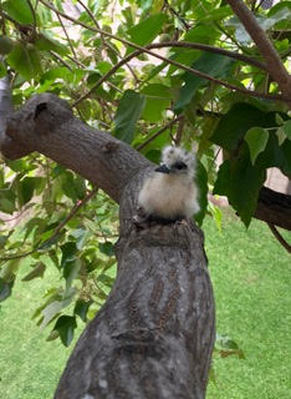|
For the first several days tending a newly hatched chick is a full-time family effort. At this early age, one adult remains with the chick, brooding it to help it thermal regulate, while the other adult forages offshore. After catching fish of appropriately small size, the adult returns to the nest site and offers them to the chick, doing its best to help the chick take the fish head first. The young hatchling's inexperience and the difference in bill lengths makes grasping the last fish from the adult particularly challenging. It's therefore not unusual for the other adult to take that last fish with the tip of its bill and offer it to the chick. After temporarily satisfying its hunger one of the adults often then preens the chick a bit before it resumes brooding it. The second adult heads back out to sea and the cycle begins again. Here's the latest white tern chick arrival in The Tree at St Andrews Cathedral. It hatched January 14th and this photo was taken the next day by our team arborist (Lake Gibby) as he was tending the cameras in tree that will monitor its growth and development. The photo shows how white tern chicks, from the moment they hatch, are equipped to grip and hold on to the branch where they'll spend the first several weeks of their life. This adaptation contributes to the relatively high survival rate the tern chicks enjoy despite the precarious perches their parents often pick for nesting sites on windy Oahu.
|
Archives
February 2024
Categories |
